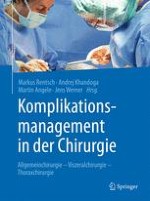Zusammenfassung
Die Morbidität und Mortalität nach Lebertransplantation ist hoch und wird vor allem durch den klinischen Zustand des Patienten, aber auch durch die Qualität des Spenderorgans bestimmt. Neben den üblichen Risikofaktoren für eine Operation wie Alter und Komorbidität spielen bei der Lebertransplantation zusätzlich die Schwere der Lebererkrankung, ausgedrückt durch den labMELD-Score, ein schlechter Performance-Status und der Grad der Katabolie/Sarkopenie eine bedeutende Rolle. Ab einem labMELD-Score von über 25 nimmt das Einjahresüberleben deutlich ab. Dies gilt auch für Patienten, die aufgrund der Schwere ihrer Erkrankung über einen längeren Zeitraum vor der Transplantation auf einer Intensivstation behandelt werden mussten.











